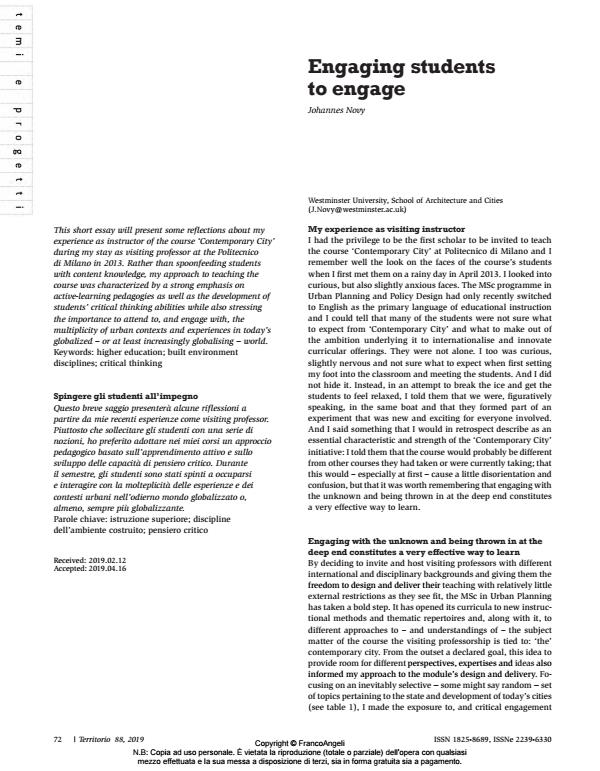Engaging students to engage
Titolo Rivista TERRITORIO
Autori/Curatori Johannes Novy
Anno di pubblicazione 2019 Fascicolo 2019/88 Lingua Inglese
Numero pagine 4 P. 72-75 Dimensione file 561 KB
DOI 10.3280/TR2019-088011
Il DOI è il codice a barre della proprietà intellettuale: per saperne di più
clicca qui
Qui sotto puoi vedere in anteprima la prima pagina di questo articolo.
Se questo articolo ti interessa, lo puoi acquistare (e scaricare in formato pdf) seguendo le facili indicazioni per acquistare il download credit. Acquista Download Credits per scaricare questo Articolo in formato PDF

FrancoAngeli è membro della Publishers International Linking Association, Inc (PILA)associazione indipendente e non profit per facilitare (attraverso i servizi tecnologici implementati da CrossRef.org) l’accesso degli studiosi ai contenuti digitali nelle pubblicazioni professionali e scientifiche
This short essay will present some reflections about my experience as instructor of the course ‘Contemporary City’ during my stay as visiting professor at the Politecnico di Milano in 2013. Rather than spoonfeeding students with content knowledge, my approach to teaching the course was characterized by a strong emphasis on active-learning pedagogies as well as the development of students’ critical thinking abilities while also stressing the importance to attend to, and engage with, the multiplicity of urban contexts and experiences in today’s globalized - or at least increasingly globalising - world.
Questo breve saggio presenterà alcune riflessioni a partire da mie recenti esperienze come visiting professor. Piuttosto che sollecitare gli studenti con una serie di nozioni, ho preferito adottare nei miei corsi un approccio pedagogico basato sull’apprendimento attivo e sullo sviluppo delle capacità di pensiero critico. Durante il semestre, gli studenti sono stati spinti a occuparsi e interagire con la molteplicità delle esperienze e dei contesti urbani nell’odierno mondo globalizzato o, almeno, sempre più globalizzante.
Keywords:Istruzione superiore; discipline dell’ambiente costruito; pensiero critico
- Flyvbjerg B., 2002, ≪Bringing power to planning research: One researcher’s praxis story≫. Journal of Planning Education and Research, 21, 4: 353-63.
- McFarlane C., 2008, ≪Urban shadows: materiality, the ‘Southern city’ and urban theory≫. Geography Compass, 2, 2: 340-358.
- Paddison R., 2001, ≪Studying cities≫. In: Paddison R. (ed.), Handbook of Urban Studies, London: Sage Publications.
- Robinson J., 2013, ≪The urban now: Theorising cities beyond the new≫. European Journal of Cultural Studies, 16, 6: 659-67.
- Schön D.A., 1983, The reflective practitioner: how professionals think in action. Aldershot: Arena.
- Yiftachel O., 2001, ≪Outlining the power of planning≫. In: Yiftachel O. et al. (eds.), The Power of Planning: Spaces of Control and Transformation. Dordrecht: Kluwer Academic Publishers.
Johannes Novy, Engaging students to engage in "TERRITORIO" 88/2019, pp 72-75, DOI: 10.3280/TR2019-088011